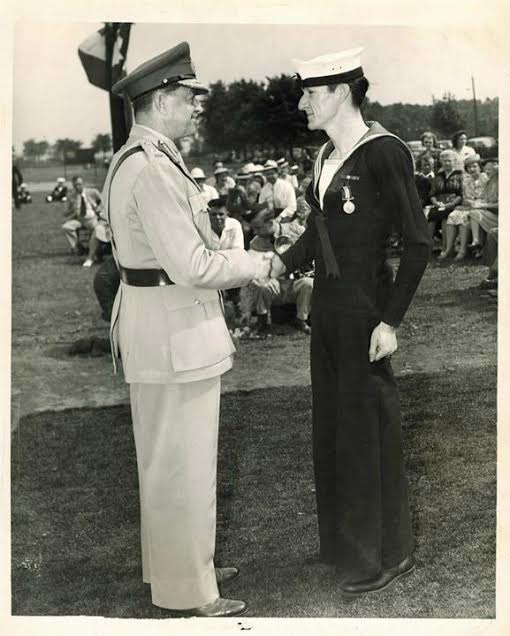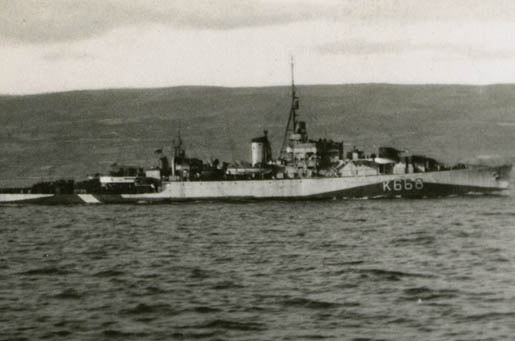Radar operator saved hundreds of lives by locating U-boat

DND
Thomas Simpson, right, receives the Distinguished Service Medal from British Field Marshal Harold Alexander in 1946.
German U-boat 1302, fully loaded with 14 torpedoes, lurked in St. George’s Channel between Ireland and the United Kingdom.
It was March 1945 and the submarine had already sunk three warships in three days.
It was ready for more.
Able Seaman (AB) Thomas Simpson, 23, was aboard His Majesty’s Canadian Ship (HMCS) La Hulloise, sailing with HMC Ships Strathadam and Thetford Mines in Escort Group 25. Their job was to protect a 31-ship convoy sailing from Halifax to England.
Although the Battle of the Atlantic was nearly over, deadly U-boats still posed a constant threat.
As one of the Royal Canadian Navy’s (RCN) first radar operators, Simpson’s role in hunting U-boats was vital in keeping the shipping lanes open and the waters around the United Kingdom and Canada safe. His job required constant alertness for days on end, because at any moment a German torpedo could come racing silently from the depths.
It was at 3 a.m. on March 7 when Simpson picked up a radar contact in St. George’s Channel. The weather was good and the sea was calm.
He immediately alerted La Hulloise’s officer of the watch, who acknowledged the contact but dismissed it as a navigational buoy.
Simpson went back to his post but again picked up the same contact, which he said was “two pips off the port beam.” He made a second radar report to the officer of the watch, who again dismissed it, stating that it was not possible for a U-boat to be so close to the coast. The charts clearly marked a buoy in that location. He told Simpson he was “seeing gremlins” and to continue his sweep.
The captain of La Hulloise, Lieutenant-Commander John Brock, hearing the verbal confrontation from his cabin below the bridge, came up top to find out what the problem was. Simpson, worried the convoy and escort ships were in imminent danger, told the captain of his first and second contact reports and how the officer of the watch had ignored them.
By this time, the ship’s sonar operator had also gained contact on the same bearing.
Brock ordered the ship brought around to head in the direction of the buoy. Some 100 yards from it, the captain ordered the 20-inch searchlight to pinpoint it in the darkness.
A periscope and snorkel came into view.
“Now the sub was hiding alongside the buoy in an attempt to avoid being detected. And in doing so, it’s expelling carbon dioxide from its battery,” said Simpson during an interview with The Memory Project.
“At that moment La Hulloise fired off star shells to illuminate the night sky, then descended upon the area of the snorkel. At that point, the sub realized that it was being attacked and started to dive. There was contact between the ship and the sub, which sent the sub to the bottom where it stayed.”
The two other escort vessels, Strathadam and Thetford Mines, launched a depth charge attack. The attack continued over some time until an oil slick and debris were observed. Items from U-1302 now came to the surface and boats were launched to recover some of the debris, which included personal letters and journals from the engine room.
All 48 submariners were lost.
According to his grandson Ronald Simpson, AB Simpson was haunted by his actions for years.
“Forty-eight men,” he said. “I think of what agonies each one must have gone through as the air ran out.”
On the other hand, he had been instrumental in saving hundreds of lives that night as his attention to duty ended the reign of terror by U-boat 1302.
Returning to Liverpool, England, Simpson was called before the Admiralty Board and questioned about the events and, specifically, his actions during his watch that night.
The RCN recommended Simpson for a Mention in Dispatches, but the Royal Navy recommended more than that. George Simpson, Commodore Western Approaches, and a decorated submariner, described Simpson’s role as “an outstanding piece of work.”
“The detection of the periscope and the snorkel was invaluable in the successful prosecution of the attack.”
AB Simpson was awarded the Distinguished Service Medal (DSM) for “courage, skill and devotion to duty.”
He was one of only 114 Canadians to receive the DSM during the Second World War.
Simpson’s three years of war service leading up to that fateful night included the Battle of the St. Lawrence and convoy duty in the Mediterranean Sea and Arctic Ocean.
Despite his skill, tenacity and bravery, Simpson was self-effacing.
“I wasn’t the only one,” he said. “We did what we had to do and we hoped it was the right thing.”
He also had some advice for officers.
“When you get to be in charge, don’t underestimate a subordinate’s viewpoints, because he may have something that is very unusual.”
After the war Simpson worked as a Customs and Immigration Officer in Windsor, Ont.
With his death on January 28, 2017, at the age of 95, “Canada lost one of the greatest of a generation that put service before self,” wrote his grandson Ronald when composing Simpson’s death notice.
“Brave and courageous and with a heart of oak, Thomas Simpson summed up the sort of Canadian that we all wish we could be.”
Sources
http://www.readyayeready.com/biographies/Thomas-Simpson.php
http://www.thememoryproject.com/stories/2066:thomas-j.-simpson/
https://legionmagazine.com/en/2015/09/pips-off-the-port-beam/
Image Gallery
Page details
- Date modified:
